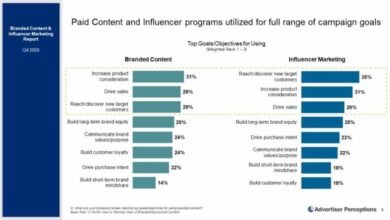
TikTok Ads A Comprehensive Guide
TikTok ads are rapidly becoming a powerful tool for businesses looking to connect with a younger, highly engaged audience. This guide dives deep into the world of TikTok advertising, covering everything from ad formats and target demographics to measuring performance and future trends. Understanding how to effectively utilize TikTok ads is crucial for maximizing ROI and reaching the right people.
We’ll explore the different ad formats available on TikTok, including in-feed, top view, and branded effects, and analyze their strengths and weaknesses. We’ll also delve into crucial targeting strategies, enabling you to reach specific demographics and interests, while demonstrating how to optimize your campaigns for maximum impact. Furthermore, we’ll discuss the critical aspects of creating engaging TikTok ads, from compelling video quality to crafting captivating ad copy, and how to leverage trending sounds and hashtags.
Introduction to TikTok Ads
TikTok advertising is a powerful tool for businesses to reach a massive, highly engaged audience. It leverages the platform’s short-form video format and user-generated content to deliver targeted messages, driving brand awareness, engagement, and ultimately, conversions. The key is understanding the unique characteristics of the TikTok ecosystem and tailoring your approach accordingly.TikTok’s advertising model goes beyond simple banner ads.
It offers a variety of creative and engaging formats, enabling businesses to connect with users on a deeper level, fostering a sense of community and brand loyalty. This dynamic environment allows for a personalized and interactive experience that resonates with the platform’s diverse user base.
Ad Formats on TikTok
TikTok offers a range of ad formats designed to capture attention and drive desired actions. These formats cater to various advertising goals, from brand awareness to direct sales.
- In-Feed Ads: These ads seamlessly integrate into the user’s TikTok feed, appearing alongside other videos. They typically include a video or image, a call to action, and a link to a website or landing page. These ads often feature trending audio or visual styles, creating a natural fit within the platform’s content flow. They are an effective way to increase brand visibility and reach.
- TopView Ads: These ads appear as the first video in a user’s feed, offering a premium placement opportunity to grab attention immediately. The longer format allows for more detailed brand messaging and storytelling. This format is ideal for businesses seeking maximum visibility and impact.
- Branded Hashtag Challenges: These interactive challenges encourage user participation by creating unique, engaging content related to a brand. Users can create and share their own videos using a branded hashtag, increasing brand exposure and generating user-generated content. The success of these challenges depends on how well the challenge resonates with the target audience and the level of creativity it inspires.
- Branded Effects: These effects, which can be filters, stickers, or other visual elements, allow users to incorporate a brand into their own videos. This interactive approach fosters brand association and recall. Brands often create custom effects to align with specific campaigns or product launches, maximizing engagement.
Target Audience Demographics for TikTok Ads
Understanding the demographics of TikTok users is crucial for effective targeting. This knowledge allows for a tailored approach to reach the specific audience most likely to engage with your brand.
- Age Range: TikTok boasts a significant presence among younger generations, typically 16-24 years old, but with a sizable portion also including users aged 25-44. A significant portion of this group actively participate in the platform’s trends, providing opportunities for businesses to connect with a younger demographic.
- Location: TikTok’s global reach is extensive. Targeting specific geographic locations can allow businesses to concentrate their advertising efforts on markets where their products or services have the highest potential for success. Localizing content can significantly improve campaign effectiveness.
- Interests and Behaviors: Users’ interests and behaviors on TikTok are diverse. Identifying key interests and behaviors is essential for targeting campaigns effectively. For example, targeting users interested in specific trends, hobbies, or product categories can yield more effective results.
Key Metrics for Tracking TikTok Campaign Success
Various metrics can be used to measure the success of TikTok campaigns. Monitoring these metrics provides valuable insights into campaign performance and allows for necessary adjustments to optimize results.
- Reach and Impressions: These metrics quantify the number of users who have seen your ad and how many times your ad has been displayed. Tracking these provides an understanding of the scale of your campaign’s exposure. High reach and impressions signify a successful initial step in brand awareness campaigns.
- Engagement Metrics: These metrics, including likes, comments, shares, and saves, measure the level of interaction with your ad. Higher engagement indicates that your ad resonates with the target audience. Understanding the factors that drive engagement is crucial for optimizing campaign effectiveness.
- Click-Through Rate (CTR): This metric measures the percentage of users who clicked on your ad’s link. A higher CTR suggests that your ad is effectively capturing interest and prompting users to take the desired action. This is a direct measure of campaign effectiveness in driving conversions.
- Conversion Rate: This metric tracks the percentage of users who completed a desired action after clicking on your ad, such as making a purchase or filling out a form. A high conversion rate signifies that your ad is effectively driving desired outcomes. Conversion rates are crucial for assessing campaign profitability.
Creating Effective TikTok Ads
TikTok ads offer a unique opportunity to reach a massive, engaged audience. Understanding the platform’s nuances and crafting compelling content is crucial for maximizing your ad’s impact. Effective TikTok ads go beyond basic visual appeal; they require a deep understanding of the platform’s algorithm, target audience, and content trends.Effective TikTok ads are not just about showing your product; they’re about creating a connection with potential customers.
They leverage the platform’s inherent energy and spontaneity to build brand awareness and drive conversions. A well-designed TikTok ad campaign can significantly boost your reach and engagement, driving traffic to your website or app and ultimately increasing sales.
Video Quality and Editing
High-quality video is paramount for TikTok ads. Poor video quality can detract from your message and damage your brand image. The fast-paced nature of TikTok demands visually appealing content that grabs attention quickly. Smooth transitions, dynamic camera angles, and engaging visuals are essential to capture the viewer’s attention in the short span of the video.TikTok’s editing tools are powerful and intuitive.
TikTok ads are a hot topic right now, but creating compelling videos is key. If you’re looking to level up your Instagram game, mastering video editing is crucial. Fortunately, there are plenty of great free and paid apps out there to help you make stunning visuals, like the best video editing apps for instagram free paid apps.
Once you’ve got those editing skills dialed in, you’ll be able to create truly captivating TikTok ads that stand out from the crowd.
Creative editing can enhance your ad’s impact, making it more memorable and engaging. Experiment with transitions, filters, and sound effects to create a unique and visually appealing experience. Consider using trending editing styles or techniques to make your ad stand out. Effective use of these tools creates a polished and professional look, vital for conveying a positive brand image.
Captivating Ad Copy, Tiktok ads
Crafting concise and engaging ad copy is crucial for TikTok ads. Short, punchy copy that speaks directly to the viewer’s needs and desires is key. Highlight the unique benefits of your product or service, and avoid generic or overly promotional language. Remember, TikTok is a platform built on relatability and humor. Incorporating a touch of humor or a relatable story can make your ad more memorable.The copy should align with the video’s content and tone.
It should also be easily readable in the video’s text overlay. Avoid using overly complex or technical language. Keep it simple and direct. Include a clear call to action, encouraging viewers to take the next step, whether it’s visiting a website or downloading an app.
Trending Sounds and Hashtags
Utilizing trending sounds and relevant hashtags is essential for increasing the visibility of your TikTok ad. Trending sounds create a sense of immediacy and relatability, tapping into current cultural trends. Hashtags help categorize your ad and increase its discoverability.Careful selection of hashtags is vital. Use a mix of broad and niche hashtags to maximize reach. Avoid using irrelevant or overly generic hashtags.
Analyze trending hashtags to identify those that resonate with your target audience. The optimal approach is a balanced strategy that uses relevant trending sounds and hashtags to improve your ad’s discoverability.
Ad Format Comparison
| Ad Format | Strengths | Weaknesses |
|---|---|---|
| In-Feed Ads | High visibility, low barrier to entry, easy to track results. | Can get lost in the feed, potentially less impactful than other formats. |
| Top View Ads | High visibility, prominent placement, strong brand impact. | More expensive, potentially less engagement than in-feed ads. |
| Branded Effects | Interactive, engaging, memorable, strong brand association. | Can be complex to create, may not be suitable for all products. |
Choosing the right ad format depends on your specific goals and budget. Each format offers different advantages and disadvantages. Consider your target audience, desired outcomes, and resources when making your decision. A strategic approach to format selection is crucial for optimizing your ad campaign’s performance.
Targeting Strategies for TikTok Ads
TikTok ads offer a powerful way to connect with your ideal audience, but simply running a campaign isn’t enough. Effective campaigns require meticulous targeting. Knowing your audience intimately allows you to craft highly relevant ad copy and visuals, leading to higher engagement and conversion rates. This approach is crucial for maximizing your return on investment.Understanding your target demographic is paramount.
This means going beyond basic information like age and location. It’s about identifying shared interests, behaviors, and values. By focusing on specific segments, your ads are more likely to resonate and encourage desired actions.
Identifying the Right Audience
To craft a successful TikTok ad campaign, pinpoint the ideal audience for your product or service. Begin by defining the characteristics of your ideal customer. Consider their age range, location, interests, and online behaviors. Use tools to research your competitors’ audiences, and understand their successful strategies. Tools such as Google Analytics or social media analytics dashboards can provide valuable insights into the demographics of your current customers and followers.
By combining this data with your product knowledge, you can refine your target audience profile.
Using TikTok’s Targeting Options
TikTok provides a suite of targeting options to help you reach your desired audience. These options allow you to refine your campaign’s focus. This allows for increased ad efficiency and reduces wasted ad spend. Effective use of these options allows you to concentrate resources on users most likely to engage with your content.
- Demographics: Targeting based on age, gender, location, and other demographic factors. For instance, if you’re selling athletic apparel, targeting young adults in specific cities with active lifestyles can yield higher results. This ensures your ads are shown to people who are most likely to be interested in your products.
- Interests: Targeting users based on their expressed interests. If you sell gardening tools, targeting users who have shown interest in gardening or DIY projects will maximize engagement.
- Behaviors: Targeting users based on their online behaviors, such as their app usage patterns or purchase history. If your product is aimed at a tech-savvy audience, targeting users who frequently download apps might be beneficial.
- Custom Audiences: Importing your existing customer lists to target users who have interacted with your brand before. This ensures your ads are shown to people who already have an interest in your products or services.
Lookalike Audiences
Lookalike audiences are a powerful tool for expanding your reach on TikTok. This method identifies users with similar characteristics to your existing customers. TikTok’s algorithm identifies these users, based on their shared characteristics with your existing customer base. This approach helps expand your reach to new potential customers who are likely to be interested in your products or services.
For example, if your existing customer base consists of young professionals, a lookalike audience might include other young professionals with similar interests and online behaviors.
Comparing Targeting Options
Different targeting options on TikTok serve distinct purposes. A detailed comparison highlights the strengths and weaknesses of each. This helps you make informed decisions about which options are most suitable for your campaign.
| Targeting Option | Description | Example |
|---|---|---|
| Demographics | Targeting users based on age, gender, location, and other demographic factors. | Targeting 18-25 year-old females in the New York City area. |
| Interests | Targeting users based on their expressed interests. | Targeting users interested in fitness, health and wellness. |
| Behaviors | Targeting users based on their online behaviors, such as app usage patterns or purchase history. | Targeting users who frequently watch videos about fashion. |
| Custom Audiences | Importing your existing customer lists to target users who have interacted with your brand before. | Targeting users who have visited your website in the past 30 days. |
| Lookalike Audiences | Identifying users with similar characteristics to your existing customers. | Creating a lookalike audience based on users who have made a purchase on your website. |
Measuring and Optimizing TikTok Ad Performance: Tiktok Ads

Tracking and analyzing TikTok ad performance is crucial for maximizing return on investment (ROI). Understanding key metrics and interpreting the data allows for informed adjustments to campaigns, ultimately leading to more effective ad spend and higher conversion rates. This process involves not only identifying successful strategies but also pinpointing areas needing improvement.Knowing what to measure and how to interpret the data is critical to refining ad campaigns.
Data-driven optimization is essential to understanding what resonates with your target audience on TikTok, ensuring your ads are seen by the right people at the right time, and leading to better results.
Key Performance Indicators (KPIs) for TikTok Ads
Understanding the metrics that matter most for TikTok ads is the first step in effective optimization. Different KPIs are important depending on your specific ad objectives. A holistic view of several metrics provides a comprehensive picture of campaign effectiveness.
TikTok ads are a hot topic right now, and rightfully so. But before you dive headfirst into a TikTok campaign, consider whether you should pause your SEO efforts during economic uncertainty. For example, should you cancel SEO during COVID-19 might be a question worth pondering. Ultimately, though, a well-rounded digital marketing strategy, including TikTok, is key to staying visible and reaching your audience.
- Impressions: The number of times your ad was displayed. High impressions show broad reach, but low engagement might indicate ineffective ad copy or targeting. Understanding impression rates helps assess whether your ad is being seen by the right audience.
- Click-Through Rate (CTR): The percentage of people who saw your ad and clicked on it. CTR is a key indicator of ad relevance and engagement. A low CTR might suggest the ad copy or visuals aren’t compelling enough or the targeting isn’t precise enough. High CTR indicates a strong call to action and effective ad messaging.
- Engagement Rate: This includes likes, comments, shares, and saves. It reflects audience interaction with your ad. A high engagement rate suggests strong resonance with your target audience. This can indicate effective content creation and successful ad copy. Low engagement could mean the ad is not compelling enough, the creative isn’t engaging, or the targeting isn’t accurate.
Monitoring this metric is vital for understanding user interaction.
- Conversion Rate: The percentage of people who saw your ad and completed a desired action (e.g., visiting your website, making a purchase). This is the ultimate measure of success, directly impacting your ROI. Conversion rate is affected by many factors, from ad copy clarity to the landing page experience. High conversion rates indicate a successful campaign, whereas low rates suggest a need to improve the ad copy, targeting, or the landing page.
- Cost Per Click (CPC): The amount you pay each time someone clicks on your ad. Understanding CPC helps manage your ad budget effectively. Analyzing CPC in conjunction with CTR allows you to assess the efficiency of your ad spend.
- Cost Per Mille (CPM): The amount you pay for one thousand impressions. CPM is essential when focusing on brand awareness campaigns. A high CPM might indicate a need to optimize targeting to reach the most relevant audience.
Interpreting TikTok Ad Data
A detailed analysis of the data is critical for effective ad campaign optimization. Understanding trends and patterns helps determine which aspects of your ads are working and which need adjustment. Consistent tracking and evaluation are key for improvement.
- Identifying Underperforming Ads: Examining the metrics of each ad helps pinpoint specific elements needing improvement. Poor CTR, low engagement, or high CPC could indicate the ad is not relevant to the audience. Analyzing CTR and engagement rate helps identify the most effective elements of each ad.
- Analyzing Audience Insights: Tracking audience engagement with different ad variations provides valuable insights into what resonates with your target audience. The data can show which creative elements, like visuals or text, receive the most interaction. Analyzing this data helps determine which aspects of your campaign resonate most strongly with the audience.
- A/B Testing Ad Variations: A/B testing involves creating different versions of your ad and testing them against each other. This helps determine which version performs better in terms of CTR, engagement, or conversions. Comparing different ad variations helps find what is most engaging for the target audience.
A/B Testing Framework
A structured approach to A/B testing is crucial for optimal results. This allows you to systematically evaluate different creative elements, ensuring the most effective versions are deployed.
- Defining Testing Objectives: Clearly defining the goals of the test ensures you measure the correct KPIs. Objectives should be specific, measurable, achievable, relevant, and time-bound.
- Identifying Variables for Testing: Identifying which aspects of the ad will be altered for the test is essential. Examples include ad copy, visuals, or call to action buttons. Identifying these variables helps in defining what will be changed in the A/B testing process.
- Creating Variations: Develop different ad versions to test against each other. The goal is to compare different versions of the ads based on the identified variables. This allows for systematic evaluation and improvement.
- Monitoring and Analyzing Results: Track the performance of each variation closely to determine which performs better. Comparing performance allows for understanding what elements resonate with the audience.
Adjusting Targeting Strategies Based on Data
Data analysis can reveal insights into the effectiveness of your targeting strategies. Understanding audience preferences and interests enables more refined targeting. This results in more focused ad delivery and higher ROI.
- Identifying High-Performing Audiences: Analyzing data helps identify the segments of your audience that are most responsive to your ads. Understanding audience segments helps refine your targeting.
- Refining Audience Segments: Based on insights from high-performing audience segments, you can refine and adjust your targeting to focus on similar demographics, interests, and behaviors. Refining audience segments allows for more effective ad delivery to the most relevant audiences.
TikTok Ad Performance Metrics Summary
| Metric | Significance |
|---|---|
| Impressions | Reach and visibility of the ad |
| CTR | Engagement and relevance of the ad |
| Engagement Rate | Audience interaction and ad resonance |
| Conversion Rate | Success in achieving desired actions |
| CPC | Efficiency of ad spend per click |
| CPM | Efficiency of ad spend per thousand impressions |
TikTok Ad Budget and ROI
TikTok advertising offers a powerful platform for reaching a vast audience, but successful campaigns require a well-defined budget and a clear understanding of return on investment (ROI). A well-planned budget, coupled with a strategy for calculating ROI and understanding the factors affecting ad costs, can significantly increase the chances of a successful campaign. Thorough analysis of successful campaigns and optimization strategies will further enhance your chances of achieving desired results.Setting a realistic budget for TikTok advertising involves several key considerations.
The budget should align with your overall marketing goals, target audience, and expected campaign performance. A crucial aspect of budgeting is understanding that TikTok advertising doesn’t guarantee immediate returns; rather, it’s a long-term investment requiring careful monitoring and adjustments.
Setting a Realistic Budget
Understanding your campaign goals and target audience is crucial for establishing a realistic budget. A small business launching a new product, for example, may benefit from a smaller budget focused on brand awareness, while an established company aiming for high-volume sales may require a more substantial budget for targeted advertising. Consider the potential return on investment (ROI) alongside the ad spend, making sure to align the investment with the expected results.
Calculating Potential ROI for TikTok Ads
Calculating potential ROI for TikTok ads involves several steps. First, define clear campaign objectives. These might include increasing brand awareness, driving website traffic, or generating sales. Next, determine the cost-per-click (CPC) or cost-per-thousand impressions (CPM) for your targeted audience. Crucially, estimate the conversion rate expected from the campaign.
Finally, project the potential number of conversions based on the estimated reach and engagement metrics. The ROI formula, (Revenue – Cost) / Cost, provides a crucial metric for evaluating the profitability of your campaign.
Factors Affecting the Cost of TikTok Ads
Several factors influence the cost of TikTok ads. These include the target audience, ad format, bidding strategy, and campaign duration. A niche audience with specific interests, for example, may command a higher cost than a broader demographic. Similarly, more engaging ad formats like video ads may command a higher price. Competition for ad placements also plays a crucial role in determining the cost.
TikTok ads are definitely a hot topic right now, but if you’re looking to expand your reach beyond the TikTok sphere, consider exploring international Facebook global pages. These pages can be a powerful tool for connecting with a wider audience, and they can be a great way to complement your TikTok ad strategy. Think of them as a broader online community, and you’ll find that a strong presence on international Facebook global pages can actually help boost your TikTok ad campaigns too.
It’s all about diversifying your marketing efforts and getting your message out to the right people.
Examples of Successful TikTok Ad Campaigns and their ROI
Numerous businesses have successfully utilized TikTok ads to achieve impressive results. A cosmetics brand, for example, might have increased sales by 25% after implementing a targeted campaign focused on user-generated content. Similarly, an e-commerce company saw a 15% increase in website traffic and a 10% boost in sales through creative ad formats and strategic targeting. These success stories highlight the potential of TikTok ads for achieving tangible results when combined with a well-defined strategy.
Strategies for Optimizing Ad Spend to Maximize ROI
Optimizing ad spend for maximum ROI involves continuous monitoring and adjustments. Track key metrics like engagement rates, click-through rates (CTR), and conversion rates. Regularly review campaign performance and adjust your targeting, bidding strategies, and ad creatives based on the data. A/B testing different ad variations is an essential tool for optimizing performance.
Budget Allocation Strategies and Impact on Campaign Results
| Budget Allocation Strategy | Impact on Campaign Results |
|---|---|
| Focus on Brand Awareness (Lower Budget) | Increased brand visibility and recognition, leading to higher long-term potential for sales and engagement. |
| High-Volume Sales Targeting (Higher Budget) | Potential for substantial increases in sales and conversions, but requires careful tracking and optimization to ensure the budget is used efficiently. |
| A/B Testing and Experimentation (Moderate Budget) | Increased efficiency and effectiveness of ad spend, allowing for optimization and identification of the most effective strategies. |
Trends and Future of TikTok Ads

TikTok ads are rapidly evolving, mirroring the platform’s dynamic user base and ever-changing content trends. Understanding these shifts is crucial for advertisers to stay relevant and maximize their return on investment. This section delves into current trends, emerging opportunities, and the potential impact of AI on future ad strategies.The success of a TikTok ad campaign hinges on staying ahead of the curve.
This requires an understanding of what resonates with the platform’s users and how their behavior is influencing the ad landscape. Adapting to these trends, while also being mindful of the challenges, is essential for advertisers to achieve optimal results.
Current Trends in TikTok Advertising
TikTok’s ad ecosystem is characterized by a blend of short-form video, influencer collaborations, and interactive features. Trends include a focus on authenticity, humor, and user-generated content, as well as a growing demand for interactive experiences. This includes polls, quizzes, and Q&A sessions that encourage user engagement. Brands are increasingly using these interactive features to create a more immersive experience for their target audience.
Emerging Opportunities in the TikTok Ad Landscape
Several emerging opportunities are presenting themselves within the TikTok ad landscape. The platform’s emphasis on creativity and trendsetting content creates an environment ripe for innovation. One emerging opportunity is leveraging the platform’s growing popularity in the creator economy. Collaborations with influencers and micro-influencers, who have built strong niche followings, are a powerful way to tap into a specific audience segment.
Furthermore, the rise of shoppable content allows for seamless transitions from viewing a product to purchasing it.
Challenges in TikTok Advertising
While opportunities abound, challenges exist. Maintaining authenticity and relevance within the fast-paced environment of TikTok trends is crucial. The platform’s algorithm is constantly evolving, and advertisers must adapt their strategies accordingly. Maintaining consistent branding while adapting to evolving user trends is also a major challenge.
Role of Artificial Intelligence in Future TikTok Ad Strategies
AI is poised to play a significant role in shaping future TikTok ad strategies. AI-powered tools can analyze user data, predict trends, and personalize ad targeting. This level of personalization can lead to more effective campaigns and higher conversion rates. AI can also assist in automating content creation, making the process more efficient. For instance, AI can help in generating video ideas based on current trends and audience interests.
Comparison of TikTok Ad Trends with Other Social Media Platforms
| Feature | TikTok | ||
|---|---|---|---|
| Content Format | Short-form video, emphasis on trends | Photos, videos, reels (short-form video) | Photos, videos, text posts |
| Engagement Style | Interactive, participatory | Interactive, but less participatory than TikTok | Passive engagement, limited interaction |
| Trend Focus | High, rapid evolution | Medium, often influenced by broader culture | Lower, more established trends |
| Targeting Capabilities | Detailed, allows for niche targeting | Detailed, with focus on demographics and interests | Detailed, with focus on demographics and interests |
Ultimate Conclusion
In conclusion, this guide has provided a thorough overview of TikTok advertising, from the basics to advanced strategies. By understanding the various ad formats, targeting options, and performance metrics, businesses can create effective campaigns that resonate with their target audience on TikTok. Leveraging the platform’s unique strengths, coupled with a strategic approach, will allow you to maximize your return on investment and reach your marketing objectives.





